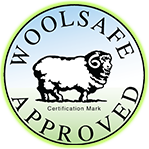Rugs add beauty, comfort and style to your home, but they also serve the benefit of noise cancellation. Muffling sounds, especially in multi-level homes or apartments, is one of the greatest advantages of adding rugs to your interior design. You naturally want to preserve your rug as long as possible, and that’s where rug pads come into play.
What are Rug Pads?
Rug pads are a sheet of cushioning that you place beneath a rug. This creates a barrier between the rug and floor, protecting both from wear-and-tear damages. When purchasing a rug pad, it’s important to consider quality.
There are many inexpensive rug pads that are made of PVC, which can emit volatile organic compounds (VOC) as well as stain your floor.
High-quality rug pads are made from natural rubber, synthetic felt or memory foam. These are much more durable and protective rug pads that will add the greatest benefit to your home.
When Should Rug Pads Be Used?
Rug pads come in various sizes to accommodate all types of area rugs. It’s an added form of protection that you purchase separately to ensure that your rug and floor stay pristine.
While they’re often advertised for hardwood floors only, we suggest using a rug pad for other types of floors as well. For example, if you purchased a rug to prevent slipping in the bathroom or entryway of your home, then a rug pad can further its efficacy.
Because the rug rests comfortably over the pad, it will not lift easily, and it is far less likely to get caught on the toe of your foot or lifted by a shoe.
Additionally, rug pads provide noise cancellation and added insulation to any space. For apartment dwellers, this can help reduce the sound of footfalls to neighbors who live on lower levels.
What Do Rug Pads Do?
Protect Your Floor
Hardwood floors are highly prone to scratching, nicks and discoloration through natural aging and use. One thing many people do not realize or anticipate is the staining of hardwood through a rug. This can occur naturally as walking on the rug can press dye through the fibers, transferring it to the boards below.
A good rug pad will protect your floor from scratches while preserving its integrity. If you have a rug anchored in place by heavy furniture, that may not always be enough to prevent indentations.
Over time, the weight of the furniture can press through the fibers, leaving permanent marks on the rug and floor.
If you have a rug on carpet, there are even rug pads designed to work over this surface. This can prevent ripples, damaged fiber and wrinkles that may lead to falls.
Increase Comfort
Many area rugs are thin, which may not make them as comfortable to walk on as you’d like.
A rug pad can easily bolster the cushioning of a thin area rug, making it instantly softer. Don’t worry about the pad making your rug suddenly too thick, either. These pads are designed to offer maximum comfort for minimal space.
Even the fluffiest area rug can feel too thin after a few years of heavy traffic. Rug pads extend the life of your rug by adding extra softness with every step. The best part is that they are far less expensive to replace than a rug itself, which allows you to keep your investment longer for minimal upkeep.
Decrease Wear-and-Tear
If you have an area rug in a space with heavy foot traffic, like a hallway or kitchen, then you’re likely to wear out your rug quickly. The added cushioning of a rug pad absorbs most of the impact from walking feet, which in turn protects the rug and maintains its quality for longer.
Additionally, the rug pad will help keep your rug plush as the padding prevents the fibers from thinning due to friction against the floor.
For those who have furniture on top of their rugs, a rug pad is an added layer of defense against accidental scrapes and scratches. Furniture can naturally shift as people use it, especially sofas, armchairs and desks. Your rug pad will ensure that your furniture and floor don’t get any unnecessary scratches from everyday use.
Improve Hygiene
You can keep your rug clean by using a rug pad to absorb much of the dirt and bacteria that would otherwise get trapped in the fibers. Even high-quality rugs can collect dust and grow mold underneath, especially if there is nothing between the rug and the floor. This is especially true in warmer climates.
The rug pad is a breathable material, designed to increase air flow and ensure that particles do not become trapped under the rug. While a rug pad can improve hygiene, you’ll still need to have your rug cleaned regularly for maximum sanitation. We suggest washing your rug and rug pad at least once per year.
Greater Safety
Rugs that are thin tend to slip and bunch, leading to falls, trips and many stubbed toes. To prevent injury and make your home safer for everyone, a rug pad can act as an anti-slip tool. The durable rubber or felt fabric is slip-resistant, so it keeps your area rug smooth and in place no matter how much you walk across it.
How Often Should You Change Rug Pads?
Most rug pads are designed to last for at least four years. After this time, they will start to lose their efficacy as the material breaks down, so it’s best to replace them and start new. This is also the perfect time to have your area rugs professionally cleaned.
For ease of maintenance, you may look for a rug pad that is machine washable. For larger rug pads, you should avoid overloading your washing machine and schedule a professional cleaning instead.
Questions About Rug Care?
If you have any questions about how to clean your area rug or preserve its quality, please reach out to us at First Class Green Cleaning today.




